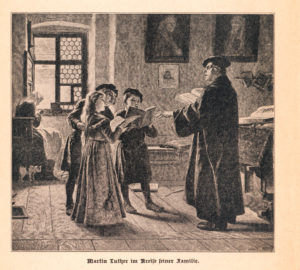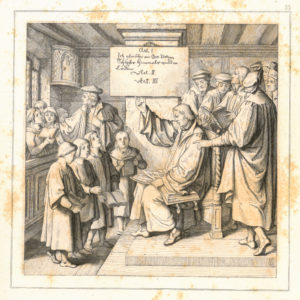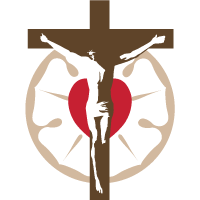by Rev. Jonathon T. Krenz
 The Large and Small Catechisms of Dr. Luther were born of pastoral necessity. In 1528, Luther and his colleagues visited the congregations in Saxony to assess their spiritual health. Luther was horrified. “Mercy! Dear God, what great misery I beheld!” Thus Luther writes in his Preface to The Small Catechism. “The common person, especially in the villages, has no knowledge whatever of Christian doctrine. And unfortunately, many pastors are completely unable and unqualified to teach… Yet, everyone says they are Christians, have been baptized, and receive the holy Sacraments, even though they cannot even recite the Lord’s Prayer or the Creed or the Ten Commandments. They live like dumb brutes and irrational hogs… O bishops! What answer will you ever give to Christ for having so shamefully neglected the people and never for a moment fulfilled your office [James 3:1]?”[1]
The Large and Small Catechisms of Dr. Luther were born of pastoral necessity. In 1528, Luther and his colleagues visited the congregations in Saxony to assess their spiritual health. Luther was horrified. “Mercy! Dear God, what great misery I beheld!” Thus Luther writes in his Preface to The Small Catechism. “The common person, especially in the villages, has no knowledge whatever of Christian doctrine. And unfortunately, many pastors are completely unable and unqualified to teach… Yet, everyone says they are Christians, have been baptized, and receive the holy Sacraments, even though they cannot even recite the Lord’s Prayer or the Creed or the Ten Commandments. They live like dumb brutes and irrational hogs… O bishops! What answer will you ever give to Christ for having so shamefully neglected the people and never for a moment fulfilled your office [James 3:1]?”[1]
The people and their pastors were woefully ignorant about the basics of the faith. Catechetical instruction had always been the key component of Luther’s program of reform. Already in 1516, he had preached and published a sermon series on the Ten Commandments, with a series on the Lord’s Prayer to follow the next year. These, along with the Creed, form the core of the Christian catechism, the basic body of doctrine every Christian should know. Catechisms were nothing new when Luther came along, and he built on the heritage he received. But he wanted this material in the ears and before the eyes of the people, and ultimately in their hearts. Originally, he asked his colleagues and friends, Justus Jonas and John Agricola, to prepare a basic catechism for use in the congregations and homes, but as it turns out, he wasn’t happy with their final product.[2] The Saxon visitation was the last straw. Luther would do the job himself. He fine-tuned the catechetical sermons he had preached over the years on the Ten Commandments, the Creed, the Lord’s Prayer, and the Sacraments, building especially on sermons he had preached in 1528. This became his Large Catechism, published in April 1529. The Small Catechism followed the next month, May 1529.

König, Gustav Ferdinand Leopold. 1900. The life of Luther in forty-eight historical engravings. St. Louis: Concordia Publishing House.
The Catechisms are both comprised of six chief parts.[3] The Ten Commandments teach us what we are to do and not do, and how we are to live. As the holy Law of God, they serve as a mirror for self-examination. They show us that we have broken God’s Commandments. We have not lived up to His good will for us, and the wages of our sin is death and eternal condemnation. The Creed teaches us what God has done to save us from sin, death, and the devil. The God who created us has redeemed us in Christ, His Son, who took on our flesh and was born of the Virgin Mary, who suffered, was crucified, died, and was buried in our place, as the price for our sins, and who is risen from the dead. The Holy Spirit brings us to faith in this Lord Jesus Christ as He works through His gifts in the Church, forgiving our sins, restoring us to the Father, giving us eternal life, and in the end, raising us from the dead. The Lord’s Prayer casts us upon our gracious Father for all our needs of body and soul. Baptism makes us God’s own child and washes away our sins. Absolution is the Word of God Himself who forgives our sins and bespeaks us righteous in Christ. The Sacrament of the Altar is Christ’s crucified and risen body and blood, given under bread and wine for us Christians to eat and to drink for the forgiveness of our sins.
While the content of the Catechisms is the same, their individual forms are tailored for different purposes. The Large Catechism reads like a book of sermons. It is intended for pastors and the the head of the Christian household to read and study so they can impart the faith in preaching and home instruction. The Small Catechism is written to be memorized. And not just by children. All Christians should know the basic texts of Christian doctrine. Luther led by example: “But for myself I say this: I am also a doctor and preacher; yes, as learned and experienced as all the people” who think they have no need of the Catechism. “Yet I act as a child who is being taught the catechism. Every morning—and whenever I have time—I read and say, word for word, the Ten Commandments, the Creed, the Lord’s Prayer, the Psalms, and such. I must still read and study them daily. Yet I cannot master the catechism as I wish. But I must remain a child and pupil of the catechism, and am glad to remain so.”[4]
 The Small Catechism was printed not only as a booklet, with each chief part outlined “As the Head of the Family Should Teach It in the Simplest Way to His Household,” but also as broadsheets (posters), convenient for hanging in Church and home for study. “Catechism” comes from the Greek word, katecho, from which we also get the word “echo.”[5] The Small Catechism is written to be echoed. The catechist (pastor, head of the house) asks a question, and the catechumen (student of the Catechism) answers with a prepared answer. As the saying goes, “Repetition is the mother of all learning.” Luther says “the Holy Spirit is present in such reading, repetition, and meditation. He bestows ever new and more light and devoutness.”[6] Read, repeat, meditate. Then do it all over again. That is how we learn the faith, as “children… begin to learn their alphabet.”[7]
The Small Catechism was printed not only as a booklet, with each chief part outlined “As the Head of the Family Should Teach It in the Simplest Way to His Household,” but also as broadsheets (posters), convenient for hanging in Church and home for study. “Catechism” comes from the Greek word, katecho, from which we also get the word “echo.”[5] The Small Catechism is written to be echoed. The catechist (pastor, head of the house) asks a question, and the catechumen (student of the Catechism) answers with a prepared answer. As the saying goes, “Repetition is the mother of all learning.” Luther says “the Holy Spirit is present in such reading, repetition, and meditation. He bestows ever new and more light and devoutness.”[6] Read, repeat, meditate. Then do it all over again. That is how we learn the faith, as “children… begin to learn their alphabet.”[7]
If Dr. Luther undertook a parish visitation today in our congregations, would he find the situation much different than that of Saxony in 1528? He would probably find a mixed bag. We hope he would find ample teaching and learning of his Catechisms and the Gospel of Christ. Our pastors are rigorously trained in the Holy Scriptures and the Christian doctrine drawn from the Bible and delivered in the Catechism. Our people attend Catechism classes for children and adults and hopefully do memory work, echoing the faith. Surely they can recite the Lord’s Prayer. They can thank God for the liturgy for that. Maybe the Creed for the same reason. The Ten Commandments? The texts for Holy Baptism and the Lord’s Supper? We always have work to do. Read, repeat, meditate. Then do it all over again.  Parents, especially fathers, teach the Catechism in the home! Get a set of broadsheets.[8] Recite the Catechism with your kids over dinner. Sing the faith![9] Pray for your pastor and support him as he seeks to teach the faith to you and to your children. Read and study The Large Catechism. This can serve as extended meditation on what you’ve learned to repeat word for word from The Small Catechism. Taken together, the Catechisms have been called “the Layman’s Bible,” because they teach the essential content of the Holy Scriptures. In other words, they still serve their original purpose: They teach us the basics of the Christian faith. And in this way, the Spirit creates and strengthens faith in Christ, our Savior.
Parents, especially fathers, teach the Catechism in the home! Get a set of broadsheets.[8] Recite the Catechism with your kids over dinner. Sing the faith![9] Pray for your pastor and support him as he seeks to teach the faith to you and to your children. Read and study The Large Catechism. This can serve as extended meditation on what you’ve learned to repeat word for word from The Small Catechism. Taken together, the Catechisms have been called “the Layman’s Bible,” because they teach the essential content of the Holy Scriptures. In other words, they still serve their original purpose: They teach us the basics of the Christian faith. And in this way, the Spirit creates and strengthens faith in Christ, our Savior.
In fact, Luther says this is the most important reason to read and study the Catechism, because it grants the Holy Spirit, who brings us to faith in Christ and drives away the devil. Indeed, “for this reason alone you ought gladly to read, speak, think, and use these things, even if you had no other profit and fruit from them than driving away the devil and evil thoughts by doing so. For he cannot hear or endure God’s Word… Yes indeed, it is the power of God that gives the devil burning pain and strengthens, comforts, and helps us beyond measure.”[10] Read, repeat, meditate. Learn it by rote, so as to learn it by heart. Then you can take it with you to your deathbed and beyond.
The Rev. Jonathon T. Krenz is pastor of Messiah Lutheran + Moscow Mission (soon to be Augustana Lutheran Church) in Moscow, Idaho.
[1] SC Preface: 2-3, 4. All quotes from Luther’s catechisms are from Concordia: A Reader’s Edition of the Book of Concord, Paul Timothy McCain et al., Eds (St. Louis: Concordia, 2005, 2006).
[2] See the “Editor’s Introduction to the Catechisms” in Concordia: A Reader’s Edition of the Book of Concord, p. 310.
[3] Originally five in the Large Catechism. A separate section on Confession was not included in the first edition, but in 1530, Luther added “An Exhortation to Confession.”
[4] LC Longer Preface: 7-8, p. 353.
[5] “Editor’s Introduction to the Catechisms,” p. 309.
[6] LC Longer Preface: 9, p. 353.
[7] LC Longer Preface: 8, p. 353.
[8] Check out the posters available at Concordia Publishing House: https://www.cph.org/p-1801-lutheran-poster-set.aspx.
[9] Again, CPH: https://www.cph.org/p-3422-sing-the-faith-cd.aspx.
[10] LC Longer Preface: 11, pp. 353-54.
